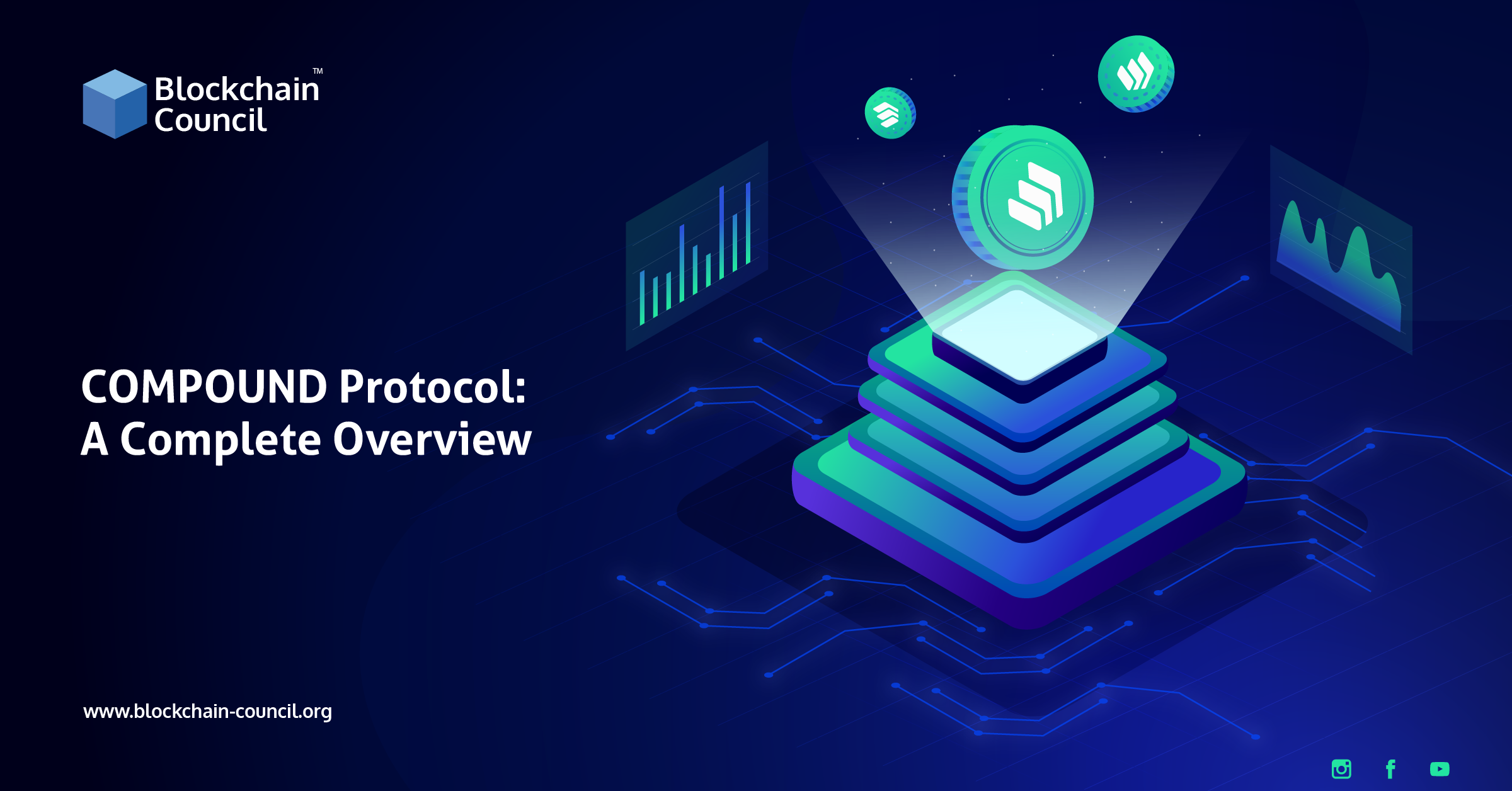
- Toshendra Kumar Sharma
- May 31, 2024
Since the beginning of 2022, the price of the Compound (COMP) token has been declining. COMP has dropped more than 43 percent from $210.27 on January 1 to $115.07 at the time of writing, according to Coin Market Cap (January 31). At the time of writing, the price is more than 87 percent lower than the all-time high of $911.20, set on May 12, 2021.
Similarly, according to DeFi Pulse, the Total Value Locked (TVL) on DeFi protocols has declined by more than 8%, from $86.24 billion on January 1 to $79.07 billion on January 31, 2022. Compound has had an even more substantial loss, with its TVL decreasing from $8.89 billion to $6.57 billion, a drop of more than 26%.
Can the compound token make a comeback in the coming months? Let’s take a closer look at the project’s fundamentals and recent events to obtain a better idea of a feasible compound crypto price projection.
Understanding Compound Protocol
Compound is an Ethereum-based DeFi borrowing and lending technology that acts as the blockchain equivalent of a money market.
An analogy with traditional banking institutions may help you better comprehend what is going on. For example, you must have a bank savings account to deposit funds to receive interest. Similarly, DeFi protocols such as Compound enable you to invest your cryptocurrency savings since your money increases due to the interest you receive. In addition, a compound, like a bank, lets you borrow money against collateral.
Compound also supports cryptocurrencies like Tether (USDT), Wrapped BTC (WBTC), Basic Attention Token (BAT), Augur (REP), Dai (DAI), Ether (ETH), USD Coin (USDC), Ox (ZRX), Sai (SAI), Uniswap (UNI), ChainLink Token (LINK), TrueUSD (TUSD), Aave Token (AAVE), Maker (MKR), Sushi Token (SUSHI), and Yearn Finance (YFI).
How does Compound function?
In its most basic form, the operation of Compound may be summarised in three points:
- Compound enables you to earn compound interest by contributing assets such as cryptocurrency to its liquidity pool.
- The compound interest rates change automatically based on the availability and demand for your particular item.
- The collateral can be paid at any moment or even withdrawn due to the unavailability of the lockup period. The deposited funds in Compound are routed through smart contracts, ensuring that the lenders retain ownership of their assets.
Mechanism of lending and borrowing
The design of DeFi lending is on smart contracts that run on open blockchains, with Ethereum blockchain serving in the instance of COMP. This lending mechanism is open to everybody because it does not require users to establish their identities.
Users who want to become lenders place their tokens in money markets set up against specific tokens such as ETH or BTC. The supply APY of the token they have contributed to the money markets is used to pay interest to these users.
Lenders supply tokens to the money market, which subsequently enter a smart contract and are accessible for borrowing by other users. The smart contract returns ctokens + interest to the lender in exchange for the borrowed tokens.
The borrower must additionally provide collateral in the form of other tokens worth more than the amount borrowed. The collateral liquidates if the value of the collateral multiplied by the collateral factor falls below the loaned amount. Therefore, the collateral’s value must always be greater than the amount borrowed.
Compound Tokens: An Overview
cTokens are tokens provided by Compound that serve as the protocol’s back-end unit of account. The lenders use these to keep track of the cryptocurrency provided by them and of the interest earned.
cTokens are directly proportional to lenders’ interest in the lending pool. When lenders contribute cash to the lending pool, they receive these tokens. Each asset has its own cToken, such as a DAI or BTC. The cToken in the case of DAI would be cDAI, and so on. Compound interest increases the value of a cToken the longer it is held by a user.
Governance
When it comes to Compound governance, it is becoming decentralized, owing to the COMP coins. These tokens entitle users who have them to governance rights and fees on the system.
Token holders can influence protocol modifications through proposals and on-chain voting. Each vote cast by token holders on proposals represents one vote for or against the proposal.
The protocol is not yet entirely decentralized, but it is well on its way to becoming so. For the time being, the most popular ideas on which users vote are on the cTokens marketplaces to list, interest rates and collateralization, and blockchain oracles.
Security
Three Trail of Bits rounds and six OpenZeppelin iterations have assessed and audited the Compound protocol regarding security. Certora also validated the Compound protocol using their Certora ASA, which is now a part of Compound’s CI system.
Compound have been assessed for economic stability by Gauntlet, a financial modeling tool for cryptocurrency. The Compound protocol grows its supported assets and volume, according to the Gauntlet outcomes.
Risks
The possibility of oversupply is a crucial factor to consider with Compound. This is referred to as ‘genetically modified yield farming‘ by Coinbase.
There are presently more DAI available on Compound than there are in the rest of the world. Impossible? Perhaps not. Compound’s liquidity is changing drastically across assets as new regulations for issuing its governance token, COMP, go into force.
So, how did this happen? Compound, on the other hand, considers each DAI deposit as an increased gross supply, even if the DAI was borrowed. So, for example, if there were 150 DAI and a user-contributed 300 USDC, the user may borrow all of the DAI and deposit again. It’s worth mentioning that some users will almost certainly be running several wallets to make this function more smoothly.
Compounding drivers
The project has reached several major milestones and advances, which may influence the price of the compound token.
Bitwise announces the launch of their Compound Fund
Bitwise, the world’s largest crypto index fund manager, will launch the Compound fund in November 2021, investing directly in COMP, the Compound protocol’s native token.
Accredited investors can subscribe to the Bitwise Compound Fund via private placement subscriptions with a minimum investment of $10,000 and weekly redemptions.
Registration on OKEx
OKEx, a cryptocurrency spot and derivatives exchange, announced in June 2020 that the COMP token would be listed on its platform, allowing traders to buy and sell the token.
Compound Treasury is now available
In June 2021, Compound Network introduced Compound Treasury to enable enterprises and financial institutions that are not crypto natives to reap the benefits of the Compound protocol.
Compound Treasury developed a product and money flow that allows significant holders of US dollars to enjoy the interest rates accessible in the USDC market of the Compound protocol. Treasury reduces the complexity of protocol-related issues like crypto-to-fiat conversion, interest rate volatility, and private key management.
Gateway’s Debut
Compound will launch a cross-chain interest rate market Gateway in March 2021. COMP token holders manage a Substrate blockchain on Ethereum. The goal of the Gateway is to enable users to borrow assets native to one chain (for example, ETH) using collateral from another chain (for example, DOT).
Price comparison of COMP/USD
ACCORDING TO ICO DROPS, the COMP token’s initial coin offering (ICO) took place on June 15, 2020, and has already delivered a 12.62 percent ROI. Compare that to the 2,612.34 percent increase in LUNA, Terra network’s native token and the highest DeFi coin by market capitalization as of January 31, according to CoinMarketCap.
Since the beginning of 2021, the price of the COMP token has been extremely optimistic, hitting a high of $534.09 on February 5 before plummeting to $346.53 on March 24. The surge continued, reaching an all-time high of $911.20 on May 12. After that, however, the price of the COMP token plummeted by more than 62 percent, reaching $342.96 on May 23 and down to $221.85 on June 21.
Between June and September, the COMP token increased by nearly 130 percent, hitting $509.8 on September 5 before plummeting to $180.98 on December 13. It ended the year with a value of $200.29.
The global cryptocurrency market has had a negative start to 2022, and COMP token has followed suit, decreasing since the beginning of the year. On January 24, it hit a 90-day low of $112.19. COMP was trading at $115.07 at the time of writing (January 31), with a market value of $752 million.
COMP future projections
Coin Codex’s short-term COMP mood remained unfavorable, with six indicators indicating optimistic signs and 23 indicating bearish indications as of January 31, 2022.
According to Coin Codex’s short-term Compound (COMP/USD) estimate, it might hit $115.67 by February 5.
Meanwhile, as of January 31, numerous algorithm-based forecasting firms provided mixed long-term compound crypto price predictions:
In its medium-term estimate, Wallet Investor predicted that the average price of COMP would reach $7.36 by the end of December 2022. In the future, it is expected that the token will recover to $67.59 by the end of December 2025. However, according to its five-year COMP/USD estimate, the price might fall to $32.31 by the end of January 2027.
COMP may average $157.3 in 2022, $185.16 in 2023, $242.77 in 2025, and $474.82 in 2029, according to Digital Coin.
Similarly, Price Prediction anticipates that the average price of COMP will be $174.21 in 2022, $524.05 in 2025, and $3,139.18 in 2030.
When looking for COMP/USD estimates, consider that both experts and algorithm-based forecasts might be inaccurate. This is because their COMP forecasts are based on fundamental and technical analyses of a cryptocurrency’s previous performance.
Historical results are not an indication of future results.
Conclusion
Compound is an intriguing option for people looking to leverage their digital assets while earning interest on their investments. It’s a terrific technique for optimizing your long-term investments if you keep a crypto asset for the long run and don’t want the danger of day trading; however, it also works for the short term. It also allows you to leverage cryptocurrency by borrowing at a protocol-determined interest rate.
The surge in the applications of DeFi platforms has projected the demand for experts with DeFi certification and has opened gateways to new opportunities.
It’s vital to do your research and bear in mind that your decision to trade is determined by your risk tolerance, market expertise, the spread of your financial portfolio, and your comfort level with losing money. Never put money into an investment that you can’t afford to lose. Before starting you can seek some expert advice. Other than this, you can choose to learn blockchain and gain awareness of this blockchain realm.





































































 Guides
Guides News
News Blockchain
Blockchain Cryptocurrency
& Digital Assets
Cryptocurrency
& Digital Assets Web3
Web3 Metaverse & NFTs
Metaverse & NFTs
